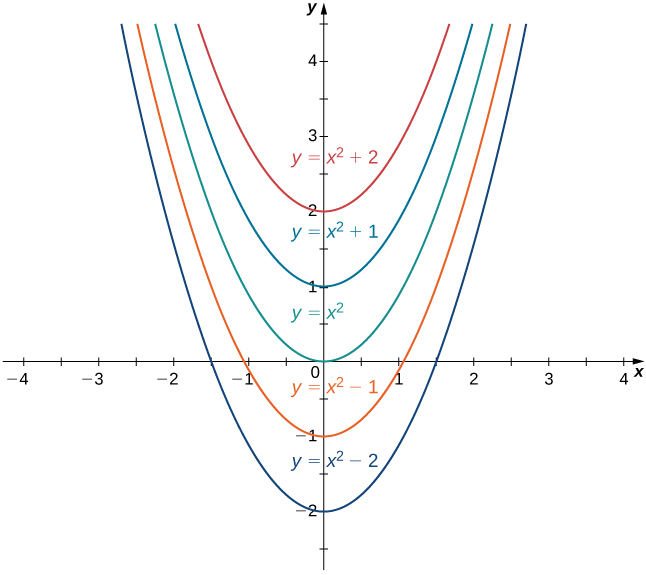Indefinite Integrals
We now look at the formal notation used to represent antiderivatives and examine some of their properties. These properties allow us to find antiderivatives of more complicated functions.
Given a function [latex]f[/latex], we use the notation [latex]f^{\prime}(x)[/latex] or [latex]\frac{df}{dx}[/latex] to denote the derivative of [latex]f[/latex]. Here we introduce notation for antiderivatives.
If [latex]F[/latex] is an antiderivative of [latex]f[/latex], we say that [latex]F(x)+C[/latex] is the most general antiderivative of [latex]f[/latex] and write
The symbol [latex]\displaystyle\int[/latex] is called an integral sign, and [latex]\displaystyle\int f(x) dx[/latex] is called the indefinite integral of [latex]f[/latex].
indefinite integral
Given a function [latex]f[/latex], the indefinite integral of [latex]f[/latex], denoted
is the most general antiderivative of [latex]f[/latex]. If [latex]F[/latex] is an antiderivative of [latex]f[/latex], then
The expression [latex]f(x)[/latex] is called the integrand and the variable [latex]x[/latex] is the variable of integration.
Given the terminology introduced in this definition, the act of finding the antiderivatives of a function [latex]f[/latex] is usually referred to as integrating [latex]f[/latex].
For a function [latex]f[/latex] and an antiderivative [latex]F[/latex], the functions [latex]F(x)+C[/latex], where [latex]C[/latex] is any real number, is often referred to as the family of antiderivatives of [latex]f[/latex].
Since [latex]x^2[/latex] is an antiderivative of [latex]2x[/latex] and any antiderivative of [latex]2x[/latex] is of the form [latex]x^2+C[/latex], we write
The collection of all functions of the form [latex]x^2+C[/latex], where [latex]C[/latex] is any real number, is known as the family of antiderivatives of [latex]2x[/latex]. Figure 1 shows a graph of this family of antiderivatives.

For some functions, evaluating indefinite integrals follows directly from properties of derivatives.
For [latex]n \ne −1[/latex],
which comes directly from
This fact is known as the power rule for integrals.
power rule for integrals
For [latex]n \ne −1[/latex],
Evaluating indefinite integrals for some other functions is also a straightforward calculation. The following table lists the indefinite integrals for several common functions.
| Differentiation Formula | Indefinite Integral |
|---|---|
| [latex]\frac{d}{dx}(k)=0[/latex] | [latex]\displaystyle\int kdx=\displaystyle\int kx^0 dx=kx+C[/latex] |
| [latex]\frac{d}{dx}(x^n)=nx^{n-1}[/latex] | [latex]\displaystyle\int x^n dx=\frac{x^{n+1}}{n+1}+C[/latex] for [latex]n\ne −1[/latex] |
| [latex]\frac{d}{dx}(\ln |x|)=\frac{1}{x}[/latex] | [latex]\displaystyle\int \frac{1}{x}dx=\ln |x|+C[/latex] |
| [latex]\frac{d}{dx}(e^x)=e^x[/latex] | [latex]\displaystyle\int e^x dx=e^x+C[/latex] |
| [latex]\frac{d}{dx}(\sin x)= \cos x[/latex] | [latex]\displaystyle\int \cos x dx= \sin x+C[/latex] |
| [latex]\frac{d}{dx}(\cos x)=− \sin x[/latex] | [latex]\displaystyle\int \sin x dx=− \cos x+C[/latex] |
| [latex]\frac{d}{dx}(\tan x)= \sec^2 x[/latex] | [latex]\displaystyle\int \sec^2 x dx= \tan x+C[/latex] |
| [latex]\frac{d}{dx}(\csc x)=−\csc x \cot x[/latex] | [latex]\displaystyle\int \csc x \cot x dx=−\csc x+C[/latex] |
| [latex]\frac{d}{dx}(\sec x)= \sec x \tan x[/latex] | [latex]\displaystyle\int \sec x \tan x dx= \sec x+C[/latex] |
| [latex]\frac{d}{dx}(\cot x)=−\csc^2 x[/latex] | [latex]\displaystyle\int \csc^2 x dx=−\cot x+C[/latex] |
| [latex]\frac{d}{dx}( \sin^{-1} x)=\frac{1}{\sqrt{1-x^2}}[/latex] | [latex]\displaystyle\int \frac{1}{\sqrt{1-x^2}} dx= \sin^{-1} x+C[/latex] |
| [latex]\frac{d}{dx}(\tan^{-1} x)=\frac{1}{1+x^2}[/latex] | [latex]\displaystyle\int \frac{1}{1+x^2} dx= \tan^{-1} x+C[/latex] |
| [latex]\frac{d}{dx}(\sec^{-1} |x|)=\frac{1}{x\sqrt{x^2-1}}[/latex] | [latex]\displaystyle\int \frac{1}{x\sqrt{x^2-1}} dx= \sec^{-1} |x|+C[/latex] |
From the definition of indefinite integral of [latex]f[/latex], we know
if and only if [latex]F[/latex] is an antiderivative of [latex]f[/latex]. Therefore, when claiming that
it is important to check whether this statement is correct by verifying that [latex]F^{\prime}(x)=f(x)[/latex].
Each of the following statements is of the form [latex]\displaystyle\int f(x) dx=F(x)+C[/latex]. Verify that each statement is correct by showing that [latex]F^{\prime}(x)=f(x)[/latex].
- [latex]\displaystyle\int (x+e^x) dx=\dfrac{x^2}{2}+e^x+C[/latex]
- [latex]\displaystyle\int xe^xdx=xe^x-e^x+C[/latex]
Earlier, we listed the indefinite integrals for many elementary functions. Let’s now turn our attention to evaluating indefinite integrals for more complicated functions.
For example, consider finding an antiderivative of a sum [latex]f+g[/latex]. In the last example. we showed that an antiderivative of the sum [latex]x+e^x[/latex] is given by the sum [latex](\frac{x^2}{2})+e^x[/latex]—that is, an antiderivative of a sum is given by a sum of antiderivatives. This result was not specific to this example.
In general, if [latex]F[/latex] and [latex]G[/latex] are antiderivatives of any functions [latex]f[/latex] and [latex]g[/latex], respectively, then
Therefore, [latex]F(x)+G(x)[/latex] is an antiderivative of [latex]f(x)+g(x)[/latex] and we have
Similarly,
In addition, consider the task of finding an antiderivative of [latex]kf(x)[/latex], where [latex]k[/latex] is any real number. Since
for any real number [latex]k[/latex], we conclude that
These properties are summarized next.
properties of indefinite integrals
Let [latex]F[/latex] and [latex]G[/latex] be antiderivatives of [latex]f[/latex] and [latex]g[/latex], respectively, and let [latex]k[/latex] be any real number.
Sums and Differences
Constant Multiples
From this theorem, we can evaluate any integral involving a sum, difference, or constant multiple of functions with antiderivatives that are known. Evaluating integrals involving products, quotients, or compositions is more complicated. We look at and address integrals involving these more complicated functions later on in the text. In the next example, we examine how to use this theorem to calculate the indefinite integrals of several functions.
Evaluate each of the following indefinite integrals:
- [latex]\displaystyle\int (5x^3-7x^2+3x+4) dx[/latex]
- [latex]\displaystyle\int \frac{x^2+4\sqrt[3]{x}}{x} dx[/latex]
- [latex]\displaystyle\int \frac{4}{1+x^2} dx[/latex]
- [latex]\displaystyle\int \tan x \cos x dx[/latex]